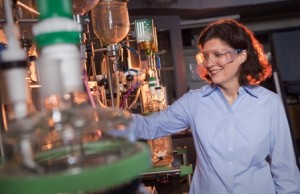
Professor Polly Piergiovanni
When Polly Piergiovanni, associate professor of chemical and biomolecular engineering, was in high school, the track coach recruited her to run the 100-yard-dash. She wasn’t a gifted athlete, or really one at all, but the coach was also her German teacher and the team was short a member.
She agreed after being assured that no one was pinning their hopes of a state championship on the swiftness of her feet, which is a good thing because she came in last every race.
Needless to say, she didn’t attend Kansas State University on a track scholarship, but the experience did teach her a thing or two about being a member of a team and working hard at something that may not come easy.
“I have more affinity for students who need extra help or are struggling to grasp a concept,” says Piergiovanni, who received her Ph.D. from the University of Houston. “I know how much heart it takes to keep going.”
With that mind, she employs a scientific version of show and tell in her classes to simplify theorems and bring the conceptual to life. As a way of illustrating exponential decay, she’ll pull out a device used to slow the speed of a closing screen door. Chains, hooks, and even Legos serve as teaching tools.
“I love the moment when the light bulb goes on,” she says.
During a First-Year Seminar, Quilts: Fabric that Communicates, Piergiovanni had students design quilts using mathematical formulas, such as Pythagorean Triples and the Fibonacci sequence.
“I don’t make them sew,” she says. “That would be very hard. They drew the patterns on paper.”
In addition, each student had a final quilt project that had to tell a story or evoke a memory. One student’s quilt paid homage to the 12 national parks she visited with her family during summer vacations. Students were also required to read an excerpt of Hidden In Plain View: A Secret Story of Quilts and the Underground Railroad and then create a quilt containing directions, in the form of a secret code or pattern, from Lafayette to their home.
“I wanted them to think critically about whether quilts were part of the Underground Railroad” as the authors of the book suggest, says Piergiovanni, who is currently making her son a quilt from favorite T-shirts for college next year.
As for her own research, Piergiovanni and chemical engineering major Carl Fiorini ’12 (Reading, Pa.) are studying stillage, a byproduct of the ethanol-from-corn process, which can be further processed and sold as cattle feed. “There are a lot of inefficiencies in the process,” she says.
Although most of her lessons are confined to the classroom and lab, Piergiovanni led a group of students to Sweden and Norway during summer break to “show engineering in a global context.” The students visited nuclear power and hydroelectric plants, a recycling center, and Volvo.
Piergiovanni then created a series of two-minute presentations from the trip, which she shows each semester during classes. “It leads to interesting discussions,” she says, reflective of engineering students’ exposure to government and law, economics, and history.
“My engineering students are much better for having taken courses in other departments,” she says. “They come in with a broader perspective.”
Despite her rocky first brush with running, Piergiovanni is still logging about 15 miles a week and will occasionally run a 5K. She’s no longer the last one across the finish line, but it really doesn’t matter to this scholar and mother of three. What counts, she says, is that you start.
